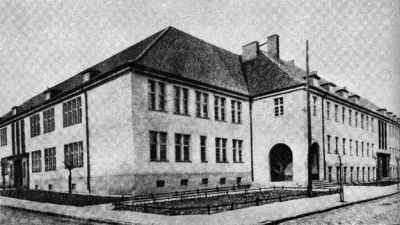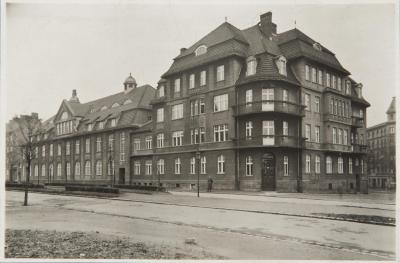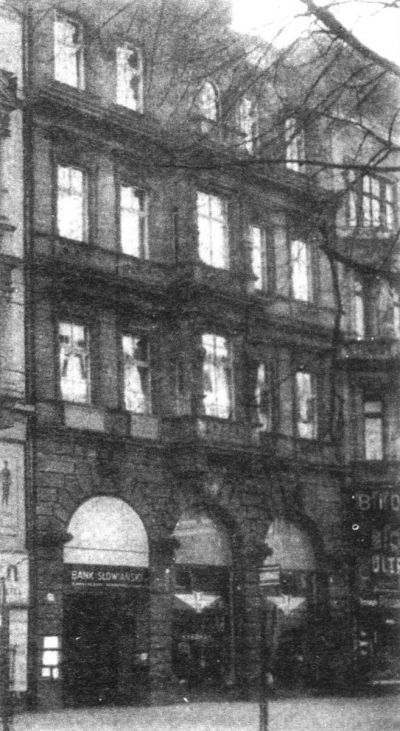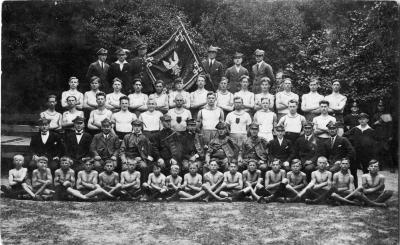The Polish grammar school in Marienwerder (Kwidzyń)

The Polish grammar school in Marienwerder (Kwidzyń) was set up in 1937 after many previous efforts to do so. Building began in 1934. The work was financed by the Slavic Bank in Berlin and completed in 1936. At the time it was one of the most modern school buildings in Eastern Prussia. The initiator of the project, Ernst Fechner, came from Olsztyn. The school building had various functions and contained a boarding school section and living quarters for the staff. The first director was Władysław Gębik. The school had a high level of learning. The usual courses were mixed with a patriotic Polish education. The school motto was “Non scholae, sed vitae discimus“ (We are not learning for school but for life). The school aimed to build a future Polish elite in Germany. All students were duty-bound to live in the boarding school independent of their home address. The teachers and other members of staff also lived in the school. Soon after it opened people began to call the school community the “Republic of Marienwerder”. The school even had its own hymn, the “Marienwerder Song”. In 1939 the Germans increased repressive measures against the school. On the 25th of August in the same year students and teachers were arrested and placed in a psychiatric institution in Gvardeysk (now in Kaliningrad Oblast). The youngest students were freed but the older students were enlisted into the army, whereas the teachers and other members of staff were imprisoned in concentration camps.
The education of young people was an important aim in the activities of Polish organisations in Germany. The usual educational duties were often tied in with a patriotic education. Only in this way was it possible to counter the Germanification of Polish young people and educate a Polish elite for a future in Germany. The supervision of education was the responsibility of the “Cooperative of Polish School Societies”(Związek Polskich Towarzystw w Niemczech). It was set up on 27th August 1922 at the same time as the “Union of Poles in Germany” (Związek Polaków w Niemczech) whose policies it implemented. The first elected chairman was the Berlin teacher Cezary Vogt. At the first General Assembly on 11th June 1923 the head of the Polish Catholic School Society in Warmia (Polsko-Katolickie Towarzystwo Szkolne na Warmię), Jan Baczewski, was elected as his successor. From the very start the society attempted to regulate the school system in Prussia. But it was not until December 1928 that the Prussian Council of Ministers decreed an “Order to Regulate the School System for the Polish minority”. This allowed, amongst other things, Poles to set up private schools in Germany. It was not an optimal solution. The schools had to be set up in autochthon areas, above all in Silesia, Warmia, Masuria and Pomerelia. The first private primary schools were set up in Opole in Silesia, and these were followed in other regions. There were a large number of problems entailed in setting up new schools. There were no suitable buildings, teachers were in short supply and schoolbooks a rarity. Furthermore the initiators were confronted at every step with harassment by Prussian civil servants, hostile German teachers, social discrimination and trickery. Any success in achieving their aims was entirely dependent on the determination of the parents.
Alongside primary schools attention was also paid to secondary schools. In 1932 people succeeded in setting up a “Polish-speaking Private Secondary School with a Grammar School Curriculum” in Bytom. Three years later this school was given public rights. 98 students entered the school in its first year of operation. In the final school year 181 students were enrolled in the grammar school.
A second private Polish grammar school was opened on the 5th November 1937 in Marienwerder in East Prussia. The selection of the location was no accident. Marienwerder was the second largest centre for Polish citizens in Germany. It took years of effort before it was possible to open the school. In 1934 a committee was set up to organise the construction of the grammar school in Marienwerder. The building was designed by the Olsztyn architect Ernst Fechner. His project, an example of modernist architecture united several functions and contained a boarding school section and accommodation for the staff. This was a highly modern solution. The school also had an assembly hall with curtains, lighting, a stage and cinema equipment. The students could follow sport lessons in a modern gymnasium equipped with showers. In addition there was an outside playing ground and a swimming bath. The school also had its own school radio.


